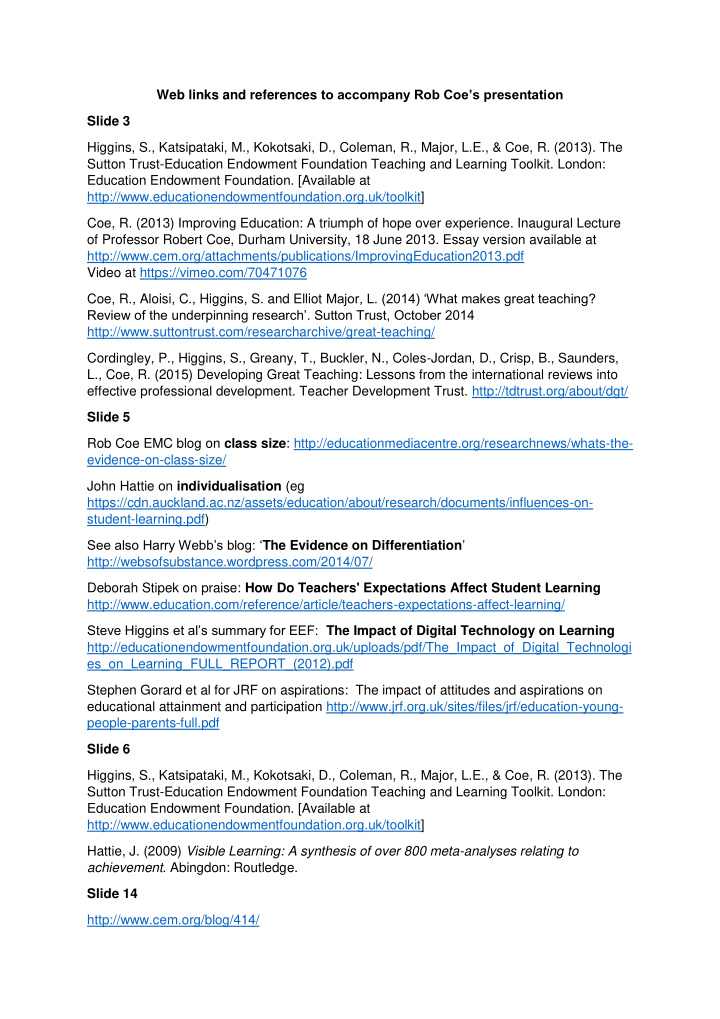



Web links and references to accompany Rob Coe’s presentation Slide 3 Higgins, S., Katsipataki, M., Kokotsaki, D., Coleman, R., Major, L.E., & Coe, R. (2013). The Sutton Trust-Education Endowment Foundation Teaching and Learning Toolkit. London: Education Endowment Foundation. [Available at http://www.educationendowmentfoundation.org.uk/toolkit] Coe, R. (2013) Improving Education: A triumph of hope over experience. Inaugural Lecture of Professor Robert Coe, Durham University, 18 June 2013. Essay version available at http://www.cem.org/attachments/publications/ImprovingEducation2013.pdf Video at https://vimeo.com/70471076 Coe, R., Aloisi, C., Higgins, S. and Elliot Major, L. (2014) ‘What makes great teaching? Review of the underpinning research’. Sutton Trust, October 2014 http://www.suttontrust.com/researcharchive/great-teaching/ Cordingley, P., Higgins, S., Greany, T., Buckler, N., Coles-Jordan, D., Crisp, B., Saunders, L., Coe, R. (2015) Developing Great Teaching: Lessons from the international reviews into effective professional development. Teacher Development Trust. http://tdtrust.org/about/dgt/ Slide 5 Rob Coe EMC blog on class size : http://educationmediacentre.org/researchnews/whats-the- evidence-on-class-size/ John Hattie on individualisation (eg https://cdn.auckland.ac.nz/assets/education/about/research/documents/influences-on- student-learning.pdf) See also Harry Webb’s blog: ‘ The Evidence on Differentiation ’ http://websofsubstance.wordpress.com/2014/07/ Deborah Stipek on praise: How Do Teachers' Expectations Affect Student Learning http://www.education.com/reference/article/teachers-expectations-affect-learning/ Steve Higgins et al’s summary for EEF: The Impact of Digital Technology on Learning http://educationendowmentfoundation.org.uk/uploads/pdf/The_Impact_of_Digital_Technologi es_on_Learning_FULL_REPORT_(2012).pdf Stephen Gorard et al for JRF on aspirations: The impact of attitudes and aspirations on educational attainment and participation http://www.jrf.org.uk/sites/files/jrf/education-young- people-parents-full.pdf Slide 6 Higgins, S., Katsipataki, M., Kokotsaki, D., Coleman, R., Major, L.E., & Coe, R. (2013). The Sutton Trust-Education Endowment Foundation Teaching and Learning Toolkit. London: Education Endowment Foundation. [Available at http://www.educationendowmentfoundation.org.uk/toolkit] Hattie, J. (2009) Visible Learning: A synthesis of over 800 meta-analyses relating to achievement . Abingdon: Routledge. Slide 14 http://www.cem.org/blog/414/
Slide 15 Strong, M., Gargani, J., & Hacifazlioglu, O. (2011). Do we know a successful teacher when we see one? Experiments in the identification of effective teachers. Journal of Teacher Education, 62 (4), 367 – 382. [Abstract at: http://jte.sagepub.com/content/62/4/367.abstract ] Slide 16 Simons, D J, Chabris, C. F (1999) Gorillas in our midst: sustained inattentional blindness for dynamic events. Perception , 1999, volume 28, pages 1059 – 1074. Slide 19 Coe, R., Aloisi, C., Higgins, S. and Elliot Major, L. (2014) ‘What makes great teaching? Review o f the underpinning research’. Sutton Trust, October 2014 http://www.suttontrust.com/researcharchive/great-teaching/ Slide 20 Correct answer is a), chosen by 17% of pupils. Common misconception is (d), chosen by 59%. Sadler, P. M., Sonnert, G., Coyle, H. P., Cook-Smith, N., & Miller, J. L. (2013). The influence of teachers’ knowledge on student learning in middle school physical science classrooms. American Educational Research Journal , 50(5), 1020-1049. Slide 21 Shulman, L S (1986) Those who understand: Knowledge growth in teaching, Educational Researcher, 15 (2), 4 – 14. http://media.education.gov.uk/assets/files/pdf/n/numeracy%20practice%20paper%202.pdf Slide 22 Ball, D. L., Thames, M. H., & Phelps, G. (2008). Content knowledge for teaching what makes it special?. Journal of teacher education, 59(5), 389-407. http://conferences.illinoisstate.edu/nsa/papers/thamesphelps.pdf Hill, H. C., Rowan, B., & Ball, D. L. (2005). Effects of teachers' mathematical knowledge for teaching on student achievement. American Educational Research Journal, 42 (2), 371-406. Slide 23 Scarborough, H. 2001. Connecting early language and literacy to later reading (dis)abilities: Evidence, theory, and practice. Pp. 97-110 in S. B. Neuman & D. K. Dickinson (Eds.) Handbook of Early Literacy. NY: Guilford Press. Slide 29 Cordingley, P., Higgins, S., Greany, T., Buckler, N., Coles-Jordan, D., Crisp, B., Saunders, L., Coe, R. (2015) Developing Great Teaching: Lessons from the international reviews into effective professional development. Teacher Development Trust. http://tdtrust.org/about/dgt/ Slide 30 The CPD Test: http://tdtrust.org/cpdtest/
Cordingley, P., Higgins, S., Greany, T., Buckler, N., Coles-Jordan, D., Crisp, B., Saunders, L., Coe, R. (2015) Developing Great Teaching: Lessons from the international reviews into effective professional development. Teacher Development Trust. http://tdtrust.org/about/dgt/ Timperley, H., Wilson, A., Barrar, H. & Fung, I. (2007) Teacher professional learning and development: Best evidence synthesis iteration. Wellington, New Zealand: Ministry of Education. http://www.educationcounts.govt.nz/publications/series/2515/15341 Slide 32 cem.org Web links and references to accompany Rob Coe’s additional slides Slide 1 Tschannen-Moran, M., & Hoy, W. K. (2000). A multidisciplinary analysis of the nature, meaning, and measurement of trust. Review of Educational Research , 70(4), 547-593. Slide 2 Bryk, A., & Schneider, B. (2002). Trust in schools. New York: Russell Sage. Hoy, W. K., Tarter, C. J., & Hoy, A. W. (2006). Academic optimism of schools: A force for student achievement. American educational research journal , 43 (3), 425-446.
Recommend
More recommend